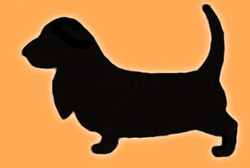Country of Origin: Great Britain
Classification FCI: Group VI - hounds and dogs to track blood - Section 1a (Hounds of small size)
Tested to work (hunting) for the International Championship. Not tested to work for the Italian Championship.
General Appearance: short legged hound of considerable substance, well balanced and distinct. It is desirable a certain amount of loose skin.
Features: tenacious dog of great lineage which hunts by smell, have pack instinct, deep melodious voice, with great endurance while hunting.
Temperament: placid, never aggressive or timid, affectionate.
Head and Skull: convex skull, the stop is slightly marked and the occipital crest is well marked. Forehead of average width and tapering slightly toward the muzzle. The muzzle is dry but not tapered. The muzzle is almost parallel to the topline of the skull and is not much longer than the skull from stop to occipit. There may be folds, in moderate amounts, on the forehead and around the eyes. In any case, the skin of the head must be sufficiently loose to form folds clearly marked when you pull forward, or when the head itself is lowered. The upper lip largely covers the lower one. The nose is completely black, except for the hounds of bright color, where it can be brown or liver. The nostrils are large and well opened, the nose may have a slight protrusion in front of the lips.
Eyes: diamond-shaped, neither protruding nor too deep-set, dark in color, but can go up to medium brown in dogs with bright coat. Expression calm and serious. The conjunctiva of the lower eyelid is visible but not excessively. Light eyes or yellow eyes are highly undesirable.
Ears: low, just below the eye line. They are long and far beyond the end of the muzzle of a certain length, but not excessively so. They are narrow along their entire length and well curled. Very flexible, fine and smooth texture.
Teeth: strong, with a perfect scissor bite, regular and complete: that is, the upper incisors covering the lower ones in close contact and perpendicularly implanted in the jaws.
Neck: muscular, well bent and of good length, has a pronounced dewlap, but without exaggeration.
Feet: blades well laid back and shoulders not heavy. The forelegs are short, powerful, and strong-boned. The elbows are not bended inwards nor outwards, they fit perfectly against the ribs of the chest. The forearm, in its upper part, is inclined inwards slightly, but not to such an extent as to disturb the freedom of movement, nor as to result in the legs touching when standing or when in action. Viewed from the side, the chest is perfectly suited to the curvature of the forearm. The skin forms folds on the forearm.
Body: The sternum is prominent, while the chest is neither narrow nor too low. The ribs are well-rounded without forming a ledge and extend well towards the rear. The back is large enough and level. The withers and kidney are approximately the same height, although the kidney may show a slight curvature. The back, from the withers to the starting point of the hips, is not excessive in length.
Hindquarters: very muscular and well built, the hind legs give roughly the impression of a sphere when viewed from the rear. Hip joint are well bent, hocks are well let down and slightly below the trunk, the hocks are not bent inward or outward, but are upright with respect to the trunk when the dog is naturally standing. Skin folds can form between hock and foot, and behind the articulation of the hock may appear a slight bag because of the laxity of the skin.
Feet: solid, equipped with good seams and well padded. The front feet may be directed forward, or turned slightly outwards but, in any case, the upright position must be perfectly regular, the weight being equally distributed on each foot and on the padding, so that the feet themselves leave the footprints of a large dog, without being in contact with the ground in any region not provided with padding.
Tail: firmly attached, fairly long, strong at the base. It thins gradually with coarse hair in moderate amounts in its lower part. In action, the tail is carried upwards to form a gentle curve, a saber, without ever being or curled.
Stride: very important feature. Smooth and uniform, with the front legs that extend well forward and rear that give a powerful boost. Ever, during the action, there must be any rigidity in the hocks and stifles. Finger should never crawl on the ground.
Hair: Smooth, short and thick without being too fine. The whole profile must be clean in its lines and free from fraying. Long hair or fringes are serious defects.
Color: generally tricolor (black, fire and white) or bicolor (lemon and white), but it is permitted any hound color.
Size: 33 to 38 inches at the withers.
Defects: Any deviation from said guidelines should be considered as a defect, which will be assessed in exact proportion to its degree.
Note: Male animals should have two apparently normal testicles fully descended into the scrotum.




